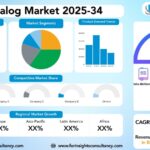
Automotive RADAR Market Research Report by Technology (Frequency-Modulated Continuous Wave (FMCW) Radar, Pulse Radar, Imaging Radar (4D Radar)), By Frequency Band (24 GHz, 77 GHz, 79 GHz), by Range, by Application, and by Region Global Market Analysis and Forecast, 2025-2034
Sep-2025 Formats | PDF | Category: Automotive | Delivery: 24 to 72 Hours
Automotive RADAR Market is forecast to increase from USD 5.33 Billion in 2025 to USD 27.76 Billion by 2034, at a CAGR of 22.8%.
Automotive RADAR Market: A Comprehensive Overview and Future Developments
Automotive RADAR is a crucial component of driver assistance systems, detecting objects and obstacles around vehicles using radio waves. It provides real-time information about the object’s distance, speed, and direction, enhancing driver safety and driving experience. The market is growing due to the demand for advanced driver assistance systems (ADAS) and the need for improved road safety.
Key developments in the future of the Automotive RADAR market include 5G integration, which will enable faster and more reliable communication between RADAR systems and other connected devices, enhancing vehicle performance. Artificial intelligence and machine learning algorithms will enable autonomous decision-making capabilities, paving the way for fully autonomous vehicles. Additionally, integrating RADAR technology with LiDAR and camera systems will provide a comprehensive view of the vehicle’s surroundings, improving safety and efficiency.
Automotive RADAR Market Dynamics
Growth Drivers
The automotive RADAR market is experiencing significant growth due to various factors. Governments worldwide are implementing stricter safety regulations, focusing on RADAR systems to enhance vehicle safety. Autonomous vehicles are also gaining popularity, with major automakers investing heavily in self-driving technologies. RADAR systems are integral to these vehicles, enabling them to navigate complex traffic conditions and unpredictable environments. Technological advancements, such as higher frequency bands and improved signal processing algorithms, are driving the adoption of RADAR systems, enhancing their performance and reliability.
Connected vehicles are also gaining traction in the automotive industry, allowing them to communicate with each other and the surrounding infrastructure. RADAR systems enable these vehicles to exchange critical information, facilitating safer and more efficient driving experiences. As the cost of RADAR sensors decreases due to economies of scale and manufacturing advancements, automotive manufacturers are increasingly incorporating RADAR systems into their vehicles, making them more accessible to a wider range of vehicle segments.
The market is also experiencing intense competition among key players, leading to rapid innovation and product development. Consumers are showing increasing acceptance of RADAR systems, driving the demand for vehicles equipped with RADAR sensors. In conclusion, the automotive RADAR market is expected to experience substantial growth in the coming years due to regulatory mandates, technological advancements, market competition, and shifting consumer preferences.
Restraints
Advanced signal processing techniques can improve the performance of Automotive RADAR systems by enhancing signal clarity and accuracy. As demand for these systems increases, manufacturers can achieve economies of scale, reducing production costs and making RADAR technology more affordable. Collaboration among industry players and regulatory bodies can streamline the regulatory process and establish common standards for RADAR technology. Additionally, research and development efforts can address the limitations of current technology by extending the range of RADAR systems, enhancing detection capabilities and expanding coverage, ultimately overcoming range constraints.
Opportunities
The Automotive RADAR market is experiencing a surge in demand due to the implementation of Advanced Driver Assistance Systems (ADAS) features such as adaptive cruise control, automatic emergency braking, and lane-keeping assist systems. This has led to a surge in the demand for safer and more intelligent vehicles. The rise of autonomous vehicles is also a game-changer for the market, as RADAR sensors are essential components of self-driving cars. The integration of connected car technology with RADAR systems is opening up new opportunities for innovation and growth.
By combining RADAR sensors with vehicle-to-vehicle and vehicle-to-infrastructure communication networks, automotive companies can create intelligent transportation systems that enhance safety and efficiency. Sensor fusion and multi-sensor integration are also being emphasized to improve the accuracy and reliability of RADAR systems. Emerging markets like China, India, and Brazil are witnessing rapid growth in the Automotive RADAR market, offering companies the opportunity to expand their presence and tap into new customer segments.
Challenges
The Automotive RADAR market faces several challenges, including interference from other electronic devices operating in the same frequency range, high costs associated with implementing RADAR technology, regulatory hurdles, and a limited range of systems. Interference can lead to inaccurate readings and potential safety hazards, while high production and integration costs can deter automakers from investing in this technology. Adhering to strict safety regulations can be time-consuming and costly, while the limited range can restrict the effectiveness of RADAR systems in certain driving conditions, potentially deterring consumers seeking comprehensive safety features in their vehicles.
Automotive RADAR Market Top Companies Covered In This Report:
Evaluate The Strategic Positioning And Innovation Pipelines Of Leading Market Companies-From Multinational Enterprises To Disruptive Regional Firms. Understand How Key Players Are Innovating, Expanding, And Capturing Value, And Use Competitive Benchmarks To Plan Your Next Move.
- NXP Semiconductors (Netherlands)
- Infineon Technologies AG (Germany)
- Valeo (France)
- Mobileye
- Magna International Inc. (Canada)
- Robert Bosch GmbH (Germany)
- Continental AG (Germany)
- Aptiv (Ireland)
- Denso Corporation (Japan)
- Renesas Electronics Corporation (Japan)
- Ficosa Internacional SA (Spain)
- Texas Instruments Incorporated (US)
Automotive RADAR Market News
Continental
In August 2025, Continental announced it had produced its 200 millionth automotive RADAR sensor, highlighting its leading position with over 20% market share. This was supported by major new orders worth around EUR 1.5 billion, with production scheduled for 2026 and 2027.
Bosch
In July 2025, Bosch unveiled its new SX600 and SX601 system-on-chips (SoCs), which are specifically designed for advanced ADAS applications up to SAE Level 2+. These new chips operate in the 77 GHz frequency band and use AI for improved perception, with the ability to detect small and distant objects with high accuracy.
Mobileye
In May 2025, Mobileye announced that a leading global automaker selected its Mobileye Imaging Radar™ as a key component for its upcoming Level 3 automated driving system, scheduled for production in 2028. This represents a significant validation of Mobileye’s “vision-first” approach complemented by a high-definition radar.
Aptiv
At CES 2025, Aptiv demonstrated its Gen 8 Radar Family, including the SRR8+ and FLR8 radars, and showcased its new production-intent chips. These solutions provide higher range and resolution and are enhanced by AI and machine learning to enable object classification and detection across diverse scenarios.
Segmented View of the Industry:
The Automotive RADAR Market Is Mapped Through A Multidimensional Lens-Tracking Shifts Across Product Type, Applications, And Geographic Regions. This Segmented Approach Enables Businesses To Localize Their Growth Plans And Align Offerings With The Most Profitable Demand Centers.
Segmentation by Technology
- Frequency-Modulated Continuous Wave (FMCW) Radar
- Pulse Radar
- Imaging Radar (4D Radar)
Segmentation by Frequency Band
- 24 GHz
- 77 GHz
- 79 GHz
Segmentation by Vehicle Type
- Passenger Cars
- Commercial Vehicles
Segmentation by Range
- Short-Range Radar (SRR)
- Medium-Range Radar (MRR)
- Long-Range Radar (LRR)
Segmentation by Application
- Adaptive Cruise Control (ACC)
- Automatic Emergency Braking (AEB)
- Blind Spot Detection (BSD)
- Collision Warning Systems
- Intelligent Park Assist
Segmentation by Sales Channel
- Original Equipment Manufacturer (OEM)
- Aftermarket
Global Geographic Coverage:
The Report Provides In-Depth Qualitative and Quantitative Data On the Automotive RADAR Market For All Of The Regions And Countries Listed Below:
North America
North America is a major market for automotive RADAR systems, driven by the demand for advanced driver assistance systems (ADAS) and autonomous vehicles. The United States and Canada are leading in technology adoption, with major players investing heavily in research and development of RADAR technology.
The presence of leading automakers and technology companies in the United States has spurred innovation and accelerated the adoption of RADAR systems in vehicles. Canada is also embracing advanced safety technologies, driven by the government’s focus on road safety and the rising demand for autonomous vehicles. As technology continues to evolve, further advancements in RADAR systems are expected to contribute to safer and more efficient transportation solutions for drivers across the region.
Europe
Germany, France, and the United Kingdom are leading the way in the development and adoption of Automotive RADAR technology. Germany, with its leading automotive manufacturers like Volkswagen, BMW, and Mercedes-Benz, has a strong presence in the global automotive market. The country’s focus on safety features and autonomous driving systems has boosted the demand for RADAR technology. The Automotive RADAR Market in Germany is expected to experience significant growth in the coming years due to advancements in sensor technology and the integration of RADAR systems in next-generation vehicles. France’s emphasis on vehicle safety and regulatory standards has propelled the demand for RADAR technology, creating new opportunities for market players. The market is characterized by evolving market trends and regulatory requirements, shaping the growth trajectory of RADAR technology in France. France presents a promising market for Automotive RADAR solutions, particularly in the context of autonomous driving systems.
The United Kingdom is also driving innovation in Automotive RADAR technology, with leading automotive companies like Jaguar Land Rover and Aston Martin actively integrating RADAR systems into their vehicles. The market is characterized by dynamic market dynamics and a competitive landscape, with established players and emerging startups vying for market share. As the demand for RADAR technology continues to surge, the UK presents lucrative opportunities for market expansion and technological innovation in the automotive sector.
Asia Pacific
The Asia Pacific region is a significant market for automotive RADAR technology, with countries like China, Japan, South Korea, and India driving growth. China’s booming automotive industry and increasing demand for advanced driver assistance systems (ADAS) have led to a surge in RADAR adoption. Major automotive players like Bosch, Continental, and Denso have a strong presence in China, fueling market growth. Japan, known for its technological advancements and innovation, is home to leading manufacturers like Toyota, Honda, and Nissan, which have integrated RADAR technology into their vehicles. The stringent regulations on vehicle safety and increasing focus on autonomous driving technologies have further boosted the demand for RADAR systems in Japan.
South Korea, with its strong research and development capabilities, is another important market for automotive RADAR technology. Companies like Hyundai and Kia have been early adopters of RADAR technology in their vehicles, driving market growth. The increasing investments in autonomous driving technology and the emphasis on vehicle safety standards are expected to further propel the growth of the automotive RADAR market in South Korea.
India is emerging as a key market for automotive RADAR technology in Asia Pacific due to the growing automotive industry and increasing awareness about vehicle safety. Rising disposable income levels and the shift towards electric vehicles have created opportunities for the adoption of RADAR systems in India. Major automotive players are introducing vehicles equipped with RADAR technology to cater to the evolving needs of Indian consumers.
Middle East and Africa
The automotive RADAR market in the Middle East and Africa region is experiencing rapid growth due to government efforts to improve road safety and technological advancements in vehicles. Companies like Continental AG and Robert Bosch GmbH are investing in the development of RADAR technology in the UAE. Saudi Arabia, known for its Vision 2030 initiative, is also a key market for automotive RADAR systems due to the demand for advanced safety features in vehicles. Israel, known for its advanced technology sector, is also at the forefront of innovation in RADAR technology, with several startups developing cutting-edge solutions for autonomous vehicles.
South Africa, one of the largest automotive markets in Africa, is experiencing growth in the automotive sector, with an increasing number of vehicles on the roads. The government’s initiatives to improve road infrastructure and safety are expected to drive the demand for automotive RADAR systems in Nigeria. Companies are investing in research and development to introduce advanced RADAR solutions in the Nigerian market.
Egypt is also experiencing growth in the automotive sector, with an increasing number of vehicles on the roads. The demand for RADAR technology is on the rise in Egypt, with automotive RADAR manufacturers eyeing the market for expansion opportunities.
Reasons to Buy:
- The Research Would Help Top Administration/Policymakers/Professionals/Product Advancements/Sales Managers And Stakeholders In This Market In The Following Ways.
- The Report Provides Automotive RADAR Market Revenues At The Worldwide, Regional, And Country Levels With A Complete Analysis To 2034 Permitting Companies To Analyze Their Market Share And Analyze Projections, And Find New Markets To Aim For.
- To Understand The Most Affecting Driving And Restraining Forces In The Market And Their Impact On The Global Market.
- Major Changes And Assessment In Market Dynamics And Developments.
- The Objective Of The Automotive RADAR Market Report Is To Identify New Business Opportunities Using Quantitative Market Forecasts.
- Formulate Sales And Marketing Strategies By Gaining An Understanding Of Competitors, Their Positioning, And Strengths & Weaknesses.
Faq – What Global Leaders Are Asking
What Is The Growth Prospect For The Automotive RADAR Market By 2034?
Automotive RADAR Market Is Expected To Achieve A Stable Growth Rate With A Compound Annual Growth Rate (Cagr) Of About 22.8% From 2025 Through 2034.
What Is Driving The Growth Of The Automotive RADAR Market?
The growth of the automotive radar market is driven by increasingly stringent government safety mandates and consumer demand for Advanced Driver-Assistance Systems (ADAS) in vehicles. This is further propelled by the industry’s shift towards higher levels of autonomy, where radar is a crucial sensor for reliable object detection and environmental perception in all weather conditions.
Who Are The Key Players In The Automotive RADAR Market, And What Are Their Market Shares?
The Automotive RADAR Market Includes Major Companies Like NXP Semiconductors (Netherlands), Infineon Technologies AG (Germany), Valeo (France), Mobileye, Magna International Inc. (Canada), Robert Bosch GmbH (Germany), Continental AG (Germany), Aptiv (Ireland), Denso Corporation (Japan), Renesas Electronics Corporation (Japan), Ficosa Internacional SA (Spain), Texas Instruments Incorporated (US), Others.
Specific Market Share Data Is Not Publicly Available and Is Typically Provided In Detailed, Proprietary Market Research Reports.
Which Regions Are Leading the Automotive RADAR Market Growth?
The Asia-Pacific region is the clear leader in the automotive RADAR market’s growth, driven by high vehicle production and the increasing adoption of ADAS features in countries like China and India. Europe also holds a significant share, fueled by stringent government safety regulations and a strong luxury automotive industry.
Customization: We Can Provide Following Things
1) On Market More Company Profiles (Competitors)
2) Data About Particular Country Or Region
3) We Will Incorporate The Same With No Additional Cost (Post Conducting Feasibility).
Any Requirement Contact Us: Https://Www.Forinsightsconsultancy.Com/Contact-Us/
Table of Contents
For TOC Contact us: https://forinsightsconsultancy.com/contact-us/







